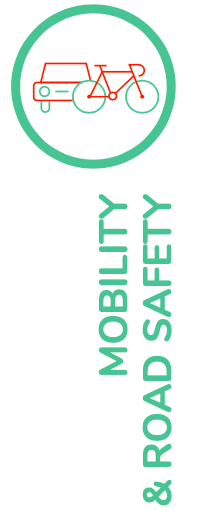Mobility & road safety
Focus area for ASToN
 The policy area chosen by Niamey is mobility & road safety.
The policy area chosen by Niamey is mobility & road safety.
For the city of Niamey, the main objective of this work is to respond to the reduction in the accident rate and congestion in the city. In 2019, 8,010 accidents were reported, in which 112 were killed and 707 were seriously injured.
These problems are caused by a number of contributing factors; unregulated public transport, road police lacking resources, and insufficient technical control.
Public transport, consisting of minibuses called Faba-faba and taxis, is not centrally coordinated, there are no dedicated timetables or stops. Vehicles are often unregistered and in poor condition. The road police operate with insufficient agents and equipment, and without a digital database. Finally, there are many vehicles on the road that have not passed their MOT and it is a challenge to encourage more people to do so. All this contributes to the issue of road safety in Niamey.
Finding: the starting point for facing these problems
The following observations define the current situation in the city of Niamey, with a specific focus on road safety issues. Based on the research carried out during phase 1, these findings express the strengths and weaknesses to be taken into account, which are often interlinked.
Population growth and the enlargement of the city mean that an efficient transport system is imperative.
Between 1952 and 2020, the population increased from 12,000 to 1.5 million inhabitants. At the same time, the city’s area has multiplied by 30. This pro- cess is described by Professor Henri Mocho of Niamey’s Abdou Moumouni University as “galloping urbanization”.
The local authority has strong leadership skills and in monitoring citizen awareness campaigns, but there are gaps in digital capabilities.
The city recently launched a campaign to educate citizens about the wearing of helmets and seat belts in traffic. They also had a campaign to improve the cleanliness of the city, Niamey Nyala, in which citizens are encouraged to clean up their area.
On the other hand, the local authority does not have sufficient internal digital capacity. Two websites for the city had previously been created, but neither was active at the time of the research.
The project is strongly supported by the Mayor, as well as being in alignment with the broader political agenda, but these may change in the next election.
The work carried out by ANSI on the Niger 2.0 Strategic Development Plan and the use of the city of Niamey as key partner on certain focal areas of the plan, give lots of space to projects like ASToN for the city of Niamey. However, in 2020, two elections are expected to take place. Both could have an impact on the project. Local elections are to take place in November 2020, and presidential elections should be held in March 2021.
In his opening speech of the budget session on 16 December 2020, the President of the City of Niamey Special Delegation invited all the staff to be more responsible and selfless at work. For this, the administration will be modernized through the digitization of processes in order to improve the services rendered to the population.
Data is an important gap for the local authority, both in terms of access to it and its use for decision-making.
All organizations, the private sector as well as the public, find it difficult to collect data relevant to their projects. The public sector could play a role in data management, so political will is required to research and analyse the data before any decision is made.
The engagement of local groups offers a new opportunity to coordinate and align the sector in a way that has not been the case before.
In the past, the transport sector has been very compartmentalized with limited communication between organizations and teams. Many participants in the local action group mentioned this as a risk for the project: “there is a lack of coordination and alignment in the transport sector”. However, many believe that progress has already been made with the creation of the local action group. The challenge for the city is to maintain this space for exchange and work.
The private sector lacks confidence in working with the public sector.
From the outside, there is not a very clear distinction between the national level and the local level, they are just considered as “public sector”. For several representatives of the private sector, start-ups in particular, entrepreneurs and players in the IT field, the government does not communicate well and the projects have no follow-up. From the point of view of start-ups, a representative said during the working session: “you have to dare to work with start-ups”.
Citizens do not always understand road safety, but local authorities could do more to understand their citizens.
The general consensus is that the lack of information and understanding on the part of citizens is a key factor in road safety. Local group participants said that “citizens need to be made aware, many of them don’t even know the rules of the road”. But to date, efforts made to understand the citizens and their needs are insufficient and this presents as a risk for the project.
Next steps
Progress made to align stakeholders in the transport sector will allow Niamey to work to improve things in a coordinated manner.
This group has a number of ideas and ambitions, for example to work on a digital identification system for vehicles and drivers, or the digitization of the continuity of taxis. The next step will be to get aligned around the first work domain.
Local authority departments involved in the project

Stakeholders involved in the ASToN Local Group

Participating in the ASToN network



